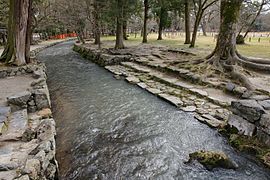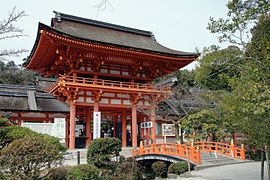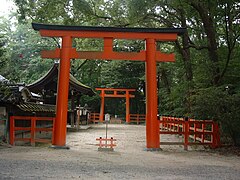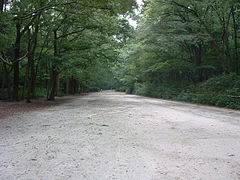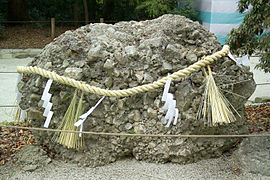Kamo shrine
The Kamo Shrine ( Japanese 賀 茂 神社 , Kamo-jinja ) in Kyōto , Japan consists of the two Shintō shrines Kamigamo-jinja ( 上 賀 茂 神社 ; literally: Upper Kamo Shrine; formerly also Kamowakeikazuchi-jinja ( 賀 茂 別 雷神 社 ; 35 ° 3 '37.3 " N , 135 ° 45' 9.6" O )); and Shimogamo-jinja ( 下 賀 茂 神社 ; literally: Lower Kamo Shrine, as it is located south of the Kamigamo Shrine; previously also Kamomioya-jinja ( 賀 茂 御 祖 神社 ; 35 ° 2 ′ 17.8 ″ N , 135 ° 46 ′ 20 , 5 ″ O )).
They are among the oldest shrines in the country and both bear the title of Chokusaisha . Both shrines are dedicated to the kami of thunder and are central parts of the Aoi festival , which is held in May and consists of a procession between the two shrines, horse racing and archery ( yabusame ). Along with several other Shrines, temples and castles in Kyoto was the Kamo Shrine in 1994 by the UNESCO for World Heritage Historic Kyoto (Kyoto, Uji and Otsu Cities) appointed.
Kamigamo shrine
The Kamigamo Shrine is the younger of the two shrines. Its exact date of construction is unknown, but most likely dates back to the 7th century . At that time, the shrine became known when members of the Japanese imperial family visited it and prayed for protection. In the early days, the shrine was under the patronage of the Kamo family, one of the most powerful noble families in Yamashiro province .
Of the 36 buildings belonging to the shrine, the main building ( Honden , rebuilt in 1628) and the auxiliary building ( Gonden ) are the most famous. Both are built in the architectural style of the Heian period and are currently one of the national treasures of Japan . The Nishimura building is the only one that is freely accessible to the public.
Omikuji available at the Kamigamo Shrine
Shimogamo shrine
The Shimogamo Shrine is believed to be about a hundred years older than the Kamigamo Shrine and thus dates before the founding of Kyoto (then Heian-kyō ). The shrine is located in the ancient forest Tadasu-no-Mori ( 糺 す の 森 , roughly forest of the search for truth ).
Of the 53 buildings in the shrine, the main east and west buildings are probably the best known, they are both national treasures of Japan. The Nagare zukuri style also dominates here. The Kami Kamotaketsunuminomikoto and Tamayorihimenomikoto have their main shrines here.
Two of the torii at Shimogamo Shrine
Ema in the shrine
Shimenawa wrapped around the sazare-ishi , the rock made of stones from the Kimi Ga Yo , the national anthem of Japan.
Remarks
Web links
- Entry on the UNESCO World Heritage Center website ( English and French ).
- Kamigamo Shrine Website (Japanese)
- Information offered by Kyoto Prefecture on the Kamigamo Shrine (English)
- Information service of the city Kyoto to Kamigamo Shrine (English)
- Information provided by Kyoto Prefecture for Shimogamo shrine (English)
- Information offered by the city of Kyoto about the Shimogamo Shrine (English)
- 六 曲 一双 、 近世 、 作者 不詳 , a pair of screens with historical paintings of a horse racing festival at the Kamigamo Shrine, owned by the Kokugakuin Shinto Museum - Japanese and English
- 賀 茂 御 蔭 祭 図 絵 巻 , Emaki with depictions of festive processions at the Shimogamo Shrine, owned by the Shintō Museum of the Kokugakuin (Japanese and English)

